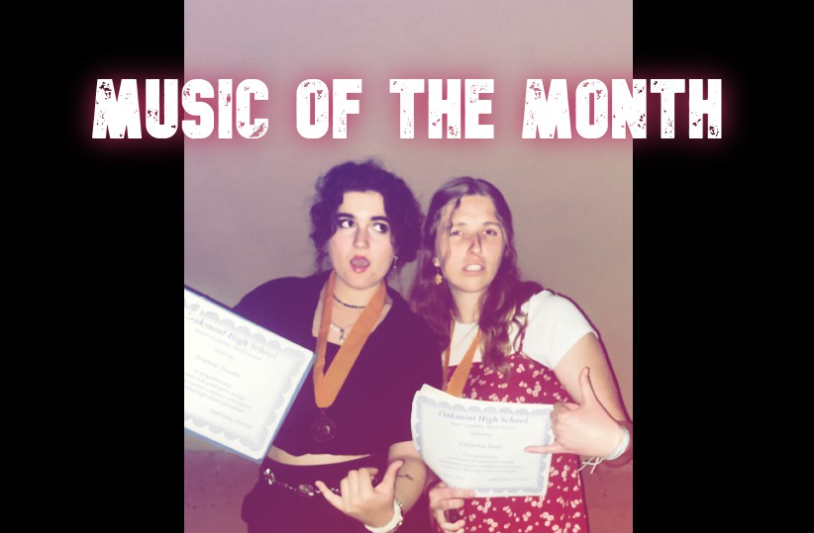Sadly, this marks the final installment of Music of the Month. It has been an immense pleasure writing about our favorite tracks each month, from the driving grooves to heart-wrenching ballads. Each track serves as a testament to the evolution of our ever-growing music taste. Thank you to our die-hard fans (you know who you are) and all the editors who have edited these monstrosities of articles.
Want to see what else we’re listening to? Check out our Spotify accounts!
Cali: Footos | The Fresh Fighter
Brianna: Benusom
Cali’s Picks
After numerous teases and the release of a series of singles, Knocked Loose finally released their third studio album, “You Won’t Go Before You’re Supposed To” on May 10. Throughout the LP, the Kentucky metalcore outfit brings a presence of pent-up rage and fury greater than any of their previous works. Rightfully carrying this energy is the seventh track, “Slaughterhouse 2,” a sequel to the 2022 acclaimed Motionless in White song (titled “Slaughterhouse”) that featured Knocked Loose’s Bryan Garris as a secondary vocalist. In contrast, this continuation presents Knocked Loose as the primary band with Chris Motionless from Motionless in White on co-vocals with Garris. Guitarist Isaac Hale opens the number up with a demonic crunching riff that abruptly quickens with Motionless’ cry of “Break down the wall again”-identical to the first installment. The first verse solely features Garris on vocals with a heavy instrumental backdrop to accompany his raucous vocals which flow into the shared chorus. Before the solo introduction of Motionless in verse two, an eclectic midsection riddled with scratching sounds and bluegrass percussion fills the airwaves. Shining more light on unique instrumentation, the second verse also brings a faint synthesizer drowned out by Kevin Otten’s booming bass. Following the second chorus is a chaotically gorgeous exchange and the eventual mixture of Garris’ and Motionless’ voices that welcome the cataclysmic breakdown with the line “One mutilation under God.” Shining in the break are Hale and drummer Pacsun Kaine, as they lower the tempo of the composition while maintaining the dooming heaviness of it all. Overall, “Slaughterhouse 2” is a face-melting banger that perfectly follows the original chapter by showcasing the intricacies in Knocked Loose’s sound while remaining a hardcore anthem for all those trying to survive in this “slaughterhouse.”
“Everyone Looks Like Everyone” by The Pack a.d., “We Kill Computers” (2012)
Serving as the second track on The Pack a.d.’s dynamic “We Kill Computers,” “Everyone Looks Like Everyone” is a fiery staple packed with explosive energy and rhythmic tones. Alike The Black Keys or The White Stripes, The Pack a.d. is a guitar-drum duo that focuses on channeling an eclectic sound, specializing in garage rock and electric blues. With this, “Everyone Looks Like Everyone” is no exception. Blasting off with a snappy guitar chord and Becky Black’s mid-range, yet powerful, croons, the composition embodies a lively spirit throughout its duration. Through staccato licks and the alliterative Maya Miller’s sequence of rolling drum beats the fleeting verse section is established. The number has no set chorus, rather a sequence of verses and a powerful bridge section. With this choppier beginning filled with hi-hats and quick licks, with each verse the band transitions into a smoother flow. The secondary verse showcases Black’s impressive writing, which airs on the side of poetry through lines like “Everyone looks like everyone/ Just like snowflakes, we’re already myth.” After the second verse, the tempo of the ditty picks up as Black takes control with her far-reaching vocal range accompanied by apt snare hits and cacophonic guitar snarls. After the repetition of the line “For we are just alike birds,” the vaulting number comes to a close with a lights-out power chord and abrupt silence. The overall composition was developed from a simple set of chords but the growth throughout the track highlights minute complexities within the sound, as well as the flawless musical chemistry between Miller and Black. Although the album serves as a Canadian cult classic, the feature of “Everyone Looks Like Everyone” in the Hulu series “Letterkenny” helped it further gain traction.
Brianna’s Picks
“Tunnel Vision” by Justin Timberlake, “The 20/20 Experience” (2013)
This 7-minute-long track embarks on a synthesized journey of infatuation. Appearing on his third studio record, “Tunnel Vision” captivates the audience through the descending back beats, engrossing orchestra, and Timberlake’s smooth vocals. Produced by Timberlake, Timbaland, and J-Roc, this R&B track is injected with EDM influence. Much like how he combines the two opposing genres, Timberlake stylistically also combines cinematography elements in his lyrics. Additionally, the hypnotizing mellow section in the middle grows into a large magnetizing display before dissipating, allowing Timberlake’s vocals to re-establish their prominence. The title, “Tunnel Vision,” refers to Timerlake’s lyrical message of focusing perceptive and limiting peripherals, reflecting the instrumental notation of dissenting notes. Throughout the track, Timberlake illuminates the concept of tunnel vision and how it affects an individual when it consumes. The radio edit of the track only offers about 5 minutes, omitting a significant portion of the intro with a very unclean cut to the intro verse and leaving out a large section of the middle and outro. “Tunnel Vision” closely rivals Timberlake’s other solo work yet surpasses the music during his boy band era regarding substance and material. This track especially showcases the abandoned bubblegum pop music. Regardless of the split reviews and critical acclaim, “Tunnel Vision” is a highlight track of Timberlake’s masterpiece of a third studio album.
“Old School Hollywood” by System of a Down, “Mezmerize” (2005)
The nu-metal band, established in Glendale in 1994, System of a Down (SOAD; System) travels roughly 8 miles to reach the focus of this track. “Old School Hollywood” opens with a phaser synth before diving into the robotic voice of SOAD’s guitarist and writer, and second vocalist Daron Malakian. Inspiration struck Malakian when he was invited to participate in the 2003 Los Angeles Dodgers’ Hollywood Stars baseball game. As he told Revolver magazine, “That was a day I spent playing baseball with Tony Danza and Frankie Avalon, who are mentioned in the song,” Malakian said. ” … I was so shocked by the situation … it was surreal, but it was a dream that wasn’t a happy dream. It was kind of dark.” This dream that Malakian describes highly mirrors the tone in the instrumentation and synth: an apparently upbeat groove overshadowed by the disappointing display of old C-list actors relying on their celebrity status. In addition to Danza and Avalon, the track also names Jack Gilardi, a casting director and actor, with the line “Jack Gilardi’s ten feet tall,” possibly relating to an inflated ego or reference to celebrities having their head in the clouds. This observation mirrors the track’s opening line where Malakain notices when “Tony Danza cuts in line.” The bridge of the track is an elongated version of the intro. Directly following the bridge, the next chorus is far more subdued regarding instrumentation. Tankian and Malakian’s vocals appear to sound much more vulnerable due to their seclusion from the abrasive instrumental. “Old School Hollywood” sets itself apart from the rest of System’s catalog. Between the synthesizers and the specific topic, however, System’s singers Malakian and Serj Tankian remain consistent with their harmonizing vocals, a fundamental aspect of their entire discography.
















